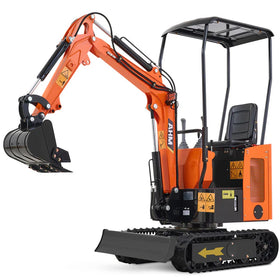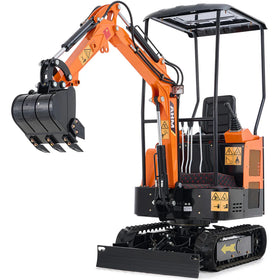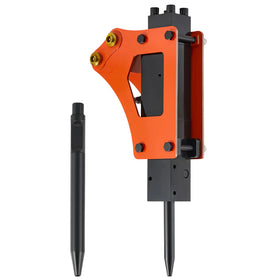Professional stump grinding costs $200-500 per stump, while renting the equipment runs $100-300 per day. That's why learning how to use a stump grinder properly saves you money if you've got multiple stumps to remove. The catch? Operating a stump grinder incorrectly can cause injuries and property damage that will cost way more than just hiring professionals in the first place.
Most professional operators can knock out a stump in 15 minutes to 3 hours, depending on the size and how hard the wood is, while doing it yourself might drag out to 1-3 days for the same work if you don’t have the proper equipment. Understanding how to use a stump grinder safely comes down to knowing the proper techniques, following safety procedures, and purchasing equipment that suits your needs.

How Does a Stump Grinder Work?
A stump grinder uses a rotating cutting wheel with carbide teeth to chip away at the wood fibers until the stump is ground down below ground level. The cutting wheel spins at high speeds - typically 830-1,250 RPM - while the carbide teeth make contact with the stump and break it into small chips.
What makes it work:
- Cutting wheel: A rotating disc that ranges from 20.5 to 24 inches in diameter
- Carbide teeth: Usually 16-34 teeth, depending on the grinder size and what it's designed for
- Hydraulic motor: Powers the wheel rotation through your skid steer's hydraulics
- Safety guards: Mesh deflectors that protect you from flying debris
When you're running a skid steer attachment, the hydraulic motor drives the cutting wheel at high RPM while you control the depth and position. With most skid steer grinders, you just drive in reverse to operate them, and 100% of your hydraulic output goes straight to the cutting wheel.
The numbers that matter:
- RPM range: 830-1,250 RPM for most skid steer attachments
- Cutting depth: 5.5-8 inches below ground per pass
- Cutting width: 2-22 inches, depending on your wheel size
- Hydraulic needs: 15-30 GPM for standard flow, 31-45 GPM for high flow

How to Use a Stump Grinder: Step by Step
Step 1: Prepare the Work Area
You need to clear everything around the stump before you fire up the grinder. Rocks and buried objects can destroy the cutting teeth fast and turn into dangerous projectiles.
Things to do:
- Call 811 to locate underground utilities before you start grinding.
- Clear all the rocks, twigs, and debris from a 10-foot radius around the stump
- Check for buried metal, old fencing, or property markers
- Mark any sprinkler lines, gas pipes, and water lines
- Trim the grass and plants around the stump so you can see what you're doing
- Cut the stump as low to the ground as possible to reduce how much grinding you need
Step 2: Get Your Safety Equipment Ready
Stump grinding throws debris at high speed, and you will get seriously hurt without proper protection.
What you must wear:
- Safety goggles or a face shield to protect your eyes
- Ear protection like earplugs or earmuffs (these things are loud)
- Hard hat with a face mask for your head and face
- Heavy-duty gloves to protect your hands
- Steel-toed work boots that won't get shredded
- Long pants and a long-sleeved shirt
- Chainsaw safety pants if you've got them
How to set up the work area:
- Put up safety cones to mark off the work zone
- Keep bystanders at least 50 feet away from the grinder
- Install a safety screen on the side where debris flies out
- Make sure all the grinder's safety features actually work
- Have a first aid kit nearby and ready to use
Step 3: Position and Start the Grinder
Getting the grinder positioned right will prevent accidents and make the job go smoother.
- Position your skid steer with the cutting wheel right at the stump edge
- Make sure you're on stable, level ground before you start
- Engage the cutting wheel and ramp it up to full operating RPM
- Be ready for a kickback when the wheel first hits the stump
- Start on one side about 1-2 inches away from the stump edge
Step 4: Grind the Stump Down
How hard it is to use a stump grinder really depends on whether you follow proper technique instead of just forcing the machine through the work.
- Use a back-and-forth sweeping motion across the stump
- Lower the cutting wheel 2-4 inches per pass, no more
- Work the wheel through the stump slowly and with control
- Only use the lower portion of the cutting wheel (imagine a clock face - work between 3:00 and 5:00)
- Never use the upper portion or try to undercut the stump
- Grind at an angle instead of straight down, as it keeps the wheel spinning faster and grinds more efficiently
Step 5: Finish Up and Clean the Area
Wrap up the job properly so the stumps don't regrow and the area is ready for whatever comes next.
- Make sure the stump is at least 6 inches below ground level
- Remove or grind any visible surface roots you can see
- Rake the wood chips into a pile for removal or use as mulch
- Fill the hole with wood chips, soil, or compost
- Level everything out for landscaping

What Kind of Stump Grinder Do You Need for a Mini Skid Steer?
Skid steer stump grinders come in standard-flow and high-flow versions, and it’s important to match the specs to what your machine can actually handle.
Hydraulic Flow Requirements
Standard-flow grinders:
- Need 15-30 GPM hydraulic flow
- Works fine on most compact skid steers
- Costs less than high-flow models upfront
- Handle residential and light commercial jobs
High-flow grinders:
- Require 30-45 GPM hydraulic flow
- Grind larger stumps faster
- Necessary for commercial operations
- Better productivity on dense hardwood
Cutting Wheel Specs
- 20.5-inch wheels work for compact applications and tight spaces
- 24-inch wheels handle standard professional work with a 22-inch cutting width
- Larger wheels cut deeper per pass, up to 8 inches
Tooth Setup
- 16-24 teeth grind faster and make larger chips
- 32-34 teeth create finer mulch but work more slowly
- 3-sided teeth can rotate to extend how long they last

Affordable Stump Grinder Attachment from AHM
The AHM stump grinder attachment delivers professional grinding power for mini skid steers at $2,199.99. With a 20.5-inch cutting wheel that spins at 1,250 RPM and 16 carbide steel cutting teeth, this grinder handles stumps of all sizes efficiently while fitting the hydraulic requirements that compact skid steers can provide.
- A 20.5-inch cutting wheel that removes stumps effectively
- 1,250 RPM rotation speed grinds through stumps fast
- 5.5-inch cutting depth gets stumps below ground level
- 2-inch cutting width works in tight spaces
- 16 carbide steel cutting teeth in 8 pairs, built to last
- Universal mount design fits standard quick-attach systems
Conclusion
Learning how to use a stump grinder safely requires proper preparation, the right protective equipment, and proper technique. Match the hydraulic requirements to your skid steer specs, follow the proper safety procedures, and you'll remove stumps efficiently without paying $200-500 per stump every time you need one gone.







